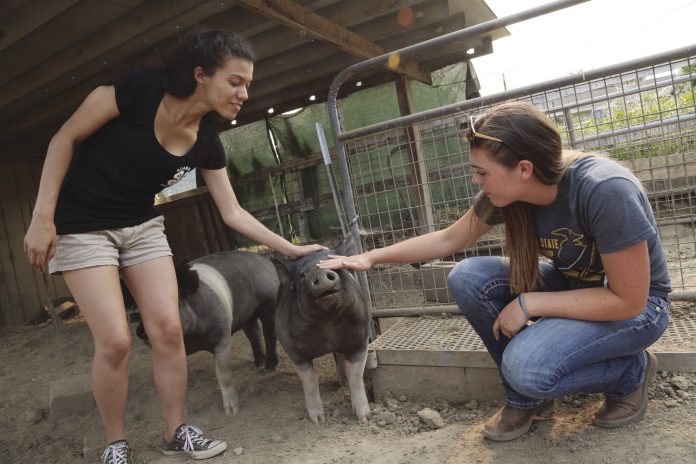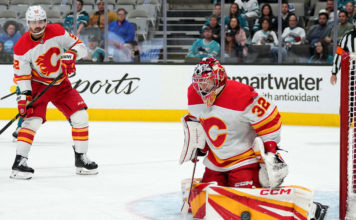From Beyonce and Jimmy Carter to Jacqueline Kennedy Onassis and Willie Nelson, 4-H and Future Farmers of America (FFA) have been helping young people across the nation build leadership skills for the last century.
For two Gilroy families, the Beyers and the Funkes, these organizations have not only taught about animal husbandry and showmanship at county fairs, like this week’s Santa Clara County Fair, but they’ve helped foster community and cultivate a personal sense of accomplishment for the kids involved.
The older of the two organizations, 4-H had its official start in 1902. It began as an extracurricular youth organization for young people ages 5-21 as a way to teach leadership, encourage citizenship and responsibility, and develop life skills. The group was later formalized with the 1914 passage of the Smith-Lever Act, which created the Cooperative Extension Service, a partnership between the USDA and land-grant universities to extend the agricultural research efforts of these universities.
Similarly, the FFA began around the same time as part of the Smith-Hughes Act (1917), which expanded upon the Smith-Lever act to allow for vocational agricultural training. Eventually, the development of a high school curriculum gave way to the FFA in 1928 when 33 students from 18 states officially formed the organization.
Cheryl Beyer, 48, enrollment chair and a leader for the Adams 4-H chapter in Gilroy, one of four chapters in South Santa Clara County, started in 4-H more than 10 years ago when her oldest child, Jasmine, was six. As a homeschooled family, Cheryl wanted to provide additional social outlets for her four children and she sought out 4-H as an extracurricular opportunity.
“Everyone thinks that your kids are going to turn out weird when you homeschool them because they think that they are sheltered,” says Cheryl, but she says her kids, like their peers, are active in their church group and in sports and dance programs.
“When they got involved in 4-H the first two projects that they took on were garden and rabbits. So for years we raised rabbits and then we added chicken and then we added swine.”
Farm to table
With the popularization of the farm to table movement, families like the Beyers and the Funkes are walking the talk. While not large scale farmers, they are raising and processing their own animals. Processing is the term used for slaughter, and Cheryl Beyer admits it’s a euphemism used by the meat packing industry.
“I think it’s a shame that we use the word ‘process’ because it divorces people from what actually happens with their food,” she says, adding that because of 4-H, her kids are very cognizant of waste.
“When we cook a chicken that they have raised, if there is anything left over, they will say ‘let’s wrap the leftovers up.’ They know what it took to get that chicken from the little chick all the way to the table because they had to do it.
“When they saw Food, Inc. they said, ‘We want to raise meat chickens because we don’t want to eat the chickens that come from the store.’ So first we raised turkeys and then we raised meat chickens.”
For people like the Funkes, who raise larger animals, there is a company that comes and slaughters them.
Kathy Funke, 51, who is an agriculture instructor at the Charter School of Morgan Hill, has roots in both FFA and 4-H, where she was a participant and leader for many years and where she met her husband, Dave.
“I taught high school agriculture over in Soquel, then when I had kids I stayed home with them and then I went back to teaching at the charter school—K-8,” says Kathy. “We have a farm at the school with goats and chickens and pigs.”
The Funkes own property in Gilroy, where they raise goats, meat birds, hens, swine, horses and, until this week’s county fair in San Jose, a steer.
Kathy’s daughter, Beth Funke, 18, says the farm to table movement is “good for us.”
“When we first moved here, our dream was to grow everything we eat,” says Kathy. Because only one animal can be sold at auction, as a market project, Kathy says her kids were raising multiple animals and selling them outside of auction. They would hold their own farm to table events after the fair, inviting the people who had purchased animals from them, and serve food they had grown on their farm.
Beth’s Supervised Agricultural Experience project this year is a steer, where she’ll take the skills she learned in her agricultural class through FFA and apply them outside of class in at fair.
“I’ve never shown a steer before,” says Beth, “so this is all very new to me. I’ve been working really hard with him and I want to sell him at the fair. My end goal is to get a good price, so $3.50 a pound.”
According to her mom, “Most of her animal projects have been market projects because we’re big into entrepreneurship here. She’s made a lot of money here.”
More than animals
But not all projects go to market. This year, in addition to showing meat hens, Joshua Beyer, 16, is showing a blown glass bowl at the fair in the “still” barn.
“That’s basically anything that’s not alive and moving,” says Jasmine Beyer, 17. “One of the coolest things about the fair is that everyone thinks that it’s animal-focused, but it’s not. You just have to go into the still barn.”
Stills could be anything, including baked goods, art, flower arranging, or photography. Jessica Beyer, 14, has previously won a blue ribbon for baking. “That was really fun!” she says. “It felt really nice to accomplish something.”
Emerging Leaders
Cheryl Beyer shares that even though a lot of the projects are agricultural, they teach young people more than animal husbandry. “It’s to teach them responsibility. It’s to teach them leadership skills.” In addition to meeting for individual project groups, 4-H clubs have a general monthly meeting, where the club gets together and discusses different projects.
“They will get up and talk about what they learned in their projects, so that’s teaching them public speaking skills,” says Cheryl.
“I still have trouble with public speaking,” says Jessica Beyer. “And because we have presentations in 4-H, I feel like it’s really helped me a lot in overcoming that fear.”
Other practices that encourage leadership are preparation for 4-H camp, where Jasmine Beyer worked as a youth leader this summer. Over a six-month period, she planned this year’s week-long summer camp with two other students and three adult advisors.
“So the project is just kind of ‘a spy in disguise’ if you will. It’s the vehicle for teaching responsibility, public speaking, money management—because that feed starts getting expensive after a while—just all of these different life skills that they can take beyond 4-H,” she says.
For more information about the local 4-H chapter, contact ad*********@***il.com or visit adams4hclub.org.













